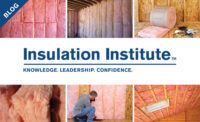Water often has been called the “elixir of life.”
Without a doubt that’s a true statement, given that water covers 70 percent of the Earth’s surface, that life emerged from the oceans and the human body is 60 percent water.
As crucial as water is to human health and wellbeing, when it comes to buildings, H20 is one of our worst enemies. Whether from precipitation breaching the building envelope, ground water seepage, high humidity or leaking pipes, water creates a host of problems in buildings, including rot, mold and erosion.
As with many other building materials, moisture adversely impacts thermal insulation. This article discusses why insulation and water don’t mix, and highlights the moisture performance of several commonly used insulation types.
Why Moisture is Bad for Insulation
As everyone knows from personal experience, your head feels much colder when your hair is wet than when it is dry. The moisture causes the hair to mat down, which reduces the insulating air trapped between hairs. Also, because water conducts heat better than hair does, damp hair provides an easier path for heat to escape from your scalp.
The same holds true for insulation exposed to moisture; its thermal performance (R-value) drops because water displaces the insulating air that is trapped in insulation. Further, water’s thermal conductivity is nearly 20 times higher than the conductivity of the average thermal insulation, according to Steve Badger, Ph.D.
How serious is the problem? “Absorption of only 20 percent moisture can cause up to 55 percent loss of insulation value,” according to Professional Service Industries Inc., a division of construction materials testing firm Intertek. As a result, to ensure the insulation does its job, it’s crucial to consider moisture performance when selecting insulation—especially in high moisture exposure applications, such as below grade and under concrete slabs.
Moisture Performance of Various Insulations
From fiberglass batts to rigid foams, virtually no insulation is immune to moisture reducing its thermal performance. However, the severity of the impact depends on how much moisture an insulation absorbs and how readily it releases moisture. Following is an overview of the moisture performance of several insulation types commonly used in building envelopes:
- Rigid foams
- Polyiso
- Extruded polystyrene (XPS)
- Expanded polystyrene (EPS)
Of course, a number of other insulation types also are available (such as spray polyurethane foam and mineral wool), but discussion of those is beyond the scope of this article.
Rigid Foams
While fiberglass batts are still widely used in stud walls, building professionals increasingly are turning to rigid foam insulation boards to meet code requirements for continuous insulation. Although these products tend to provide better moisture performance than fiberglass batts, they vary in the degree to which they absorb moisture and experience R-value loss.
Polyiso
Because of the way they are made, all polyiso insulation boards are faced products. The facer type plays a role in the insulation’s moisture performance. Foil-faced polyiso boards have permeance (perm) ratings of about 0.3 according to the Polyiso Insulation Manufacturers Association. In part because of their low perm ratings, polyiso products often are used in wall and roof applications.
EPS and XPS
EPS and XPS insulations perform very differently when it comes to moisture. EPS tends to absorb small amounts of moisture quicker, but also releases it much faster than XPS does. This has led to confusion about which material performs best, as XPS comes out ahead in the laboratory, while EPS is superior in real-world applications.
Both insulations commonly are evaluated per ASTM 272, Standard Test Method for Water Absorption of Core Materials for Sandwich Constructions. In this test, insulation samples are fully submerged in water for 24 hours, then weighed for moisture absorption immediately upon removal from the water.
The problem is this test method is designed to ensure products are manufactured to required specifications, but does not adequately reflect real-world building conditions. Unless a building is subjected to extensive flooding, its below-grade insulation is almost never fully submerged as in the laboratory test. And, unless such flooding is prolonged, the test doesn’t consider how insulation dries between periods of moisture exposure.
An independent lab Stork Twin City Testing evaluated the moisture content of EPS and XPS buried side-by-side for 15 years on a building foundation in St. Paul, Minn. At the time the insulations were removed, the EPS had only 4.8 percent moisture by volume compared to 18.9 percent moisture content for the XPS. After 30 days of drying time, the EPS had dried to only 0.7 percent moisture by volume, while the XPS still contained 15.7 percent moisture.
The Stork Twin City Testing of the two insulations also showed the degree to which moisture absorption impacts R-value. The XPS insulation lost 48 percent of its R-value, compared to only a 6 percent decrease for EPS. For additional discussion of these results, see the EPS Industry Alliance’s Technical Bulletin 103, “15-Year In-situ Research Shows EPS Outperforms XPS in R-value Retention.”
Conclusion
While water may be the “elixir of life,” as Chinese philosopher Lao Tzu said, “Nothing is softer or more flexible than water, yet nothing can resist it.” Whether it is slowly wearing down a granite mountain through erosion, or sweeping away a village in a flood, water is indeed difficult to resist. The same is true for insulation, as moisture can permeate many insulations and reduce their thermal performance.
Although building industry professionals know to consider R-value when selecting insulation for their projects, given the substantial negative impact water has on thermal performance, it also is crucial to evaluate moisture performance.







